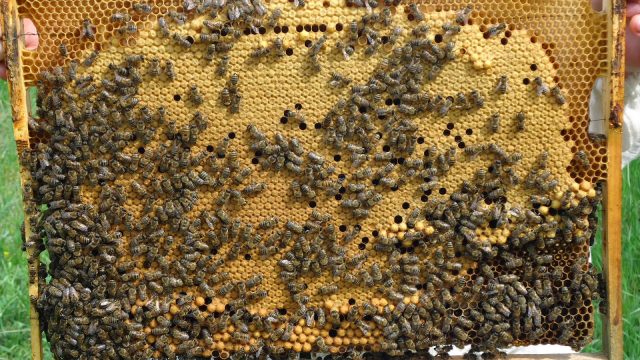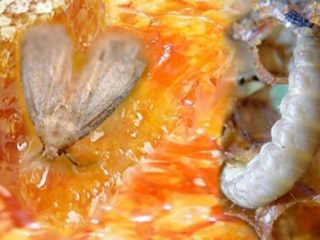Content
Bees seal empty combs when there are insufficient raw materials to produce honey. This phenomenon is observed when honey plants bloom poorly due to weather conditions (cold, damp summer). Less commonly, the cause is internal problems of the swarm (unfertilized queen, diseases of worker bees).
How is honey formed?
In early spring, when the first honey plants bloom, bees begin collecting nectar and bee bread to produce honey. It is the staple food of adult insects and brood. Work on the procurement of raw materials continues until late autumn. Nectar stored for the winter is placed in honeycombs for maturation by insects. Then, after a certain time, the filled cells will be sealed.
Honey formation process:
- When flying around honey plants, a bee is guided by color and smell. It collects nectar from flowers using its proboscis, and the pollen settles on the legs and abdomen of the insect.
- The nectar enters the harvester's crop; the structure of the digestive system allows the nectar to be kept isolated from the intestines with the help of a special partition.The insect can regulate the tone of the valve; when relaxed, part of the nectar goes to feed the individual, and the rest is delivered to the hive. This is the initial stage of honey production. During collection, the raw materials are initially enriched with an enzyme from the glands, which break down polysaccharides into substances that are easier to digest.
- The collector returns to the hive, hands over the raw materials to the receiving bees, and flies off for the next portion.
- The receiver removes excess liquid from the nectar, fills the cells, and at a certain time begins to print them; first, the insect passes a drop of raw material through the crop several times, while constantly enriching it with secretion. Then placed in the lower cells. Individuals continuously work their wings, creating air ventilation. Hence the characteristic noise inside the swarm.
- After removing excess moisture, when the product becomes thicker and there is no risk of fermentation, it is placed in the upper honeycomb and begins to be sealed for ripening.
Why do bees seal frames with honey?
When the nectar has reached the desired consistency, it is sealed in cells with a bar. Bees start printing frames from the top cells, using airtight wax disks. Thus, they protect the product from excess moisture and air so that organic substances do not oxidize. Only after sealing does the raw material mature to the required condition and can be stored for a long time.
How long does it take for bees to seal a frame of honey?
The honey production process begins from the moment the nectar is collected. After the collection bee delivers the raw materials to the hive, processing continues with a young non-flying individual.Before it begins to seal the nectar, the product goes through several stages. Gradually, it is moved from the lower honeycombs to the upper row, and hydrolysis continues in the process. From the moment of collection to the time when the bees begin to print filled cells of the honeycomb, 3 days pass.
The time to completely fill and seal the frame depends on the flowering of honey plants, weather conditions and the capabilities of the swarm. In rainy weather, bees do not fly out to collect nectar. Another factor that influences the time it takes to fill the frame and then seal it is how far the foraging bee has to fly. Under favorable conditions and good bribes, bees are able to seal a frame in 10 days.
How to speed up the sealing of honey by bees
There are several ways to stimulate bees to start printing honeycombs faster:
- So that excess moisture evaporates from the nectar and the bees begin to print it, improve ventilation in the hive by opening the lid slightly on a sunny day.
- The hive is insulated, young insects will create the necessary microclimate, intensively working with their wings, which also contributes to the evaporation of moisture and the rapid sealing of the cells.
- Provide the family with a good base for honey collection.
The temperature will rise, the moisture will evaporate faster, and insects will begin to seal the product faster.
How long does honey take to mature in a hive?
The bees seal the cells with raw materials from which excess liquid has been removed using a bar. To ensure that the product is well preserved and does not lose its chemical composition, it ripens in a sealed form. After closing the cells, it takes at least 2 weeks for the bee product to reach the desired condition. When pumping out, choose frames that are covered with 2/3 of the beam.They will contain a finished product of good quality.
Why do bees print empty honeycombs?
A phenomenon that often occurs in beekeeping is that the honeycombs are sealed in places, but there is no honey in them. Cells are printed by young individuals; this action is inherent in them at the genetic level. The entire life cycle of insects is aimed at preparing food for wintering and feeding brood. A strong family with a full-fledged uterus prints all the combs by the fall, so that during the cold season they spend less energy and nutrition on heating the nest.
List of possible reasons
The cause of sealed empty combs can be a queen who has stopped laying eggs. The bees will print frames with brood in a certain time period, regardless of the presence of babies in them. Perhaps the larva died from a number of reasons; after a few days it is also sealed with a wax disk.
The main reason why receptionists print empty honeycombs is a bad bribe. There is nothing to fill the drawn foundation, the bees begin to print empty cells, this is observed closer to autumn before the wintering of the colony. With a good honey harvest, bees will print empty combs if the swarm is equipped with a large number of frames and the colony cannot cope with the volume. If the number of empty frames does not exceed that required for a swarm, the weather is suitable for collecting nectar, and the honeycombs are poorly filled and the receivers seal them without bee product, the cause may be a disease of the collecting bees or a large distance to the honey plants.
How to fix
To fix the problem, it is necessary to determine the reason why the insects began to seal empty frames:
- If the queen stops laying eggs, the bees lay queen cells to replace them.It is impossible to leave the old queen, the swarm may not survive the winter, she should be replaced with a young one.
- The main problem in the summer is nosematosis; bees infected with mites weaken and cannot produce the required amount of raw materials. The family needs to be treated.
- In unfavorable weather conditions or a lack of honey plants, when it is discovered that the receptionists have begun to seal empty cells, the family is fed with syrup.
If there is an excessive number of frames with foundation, both young and old individuals are engaged in honeycomb pulling, and the productivity of collecting raw materials decreases. It is recommended to remove some of the frames with empty foundation, otherwise insects will begin to print empty cells.
Why don't bees print honey?
If the bees do not seal the honeycombs filled with honey, it means that the product is of poor quality (hodew), unsuitable for food, or has crystallized. Candied bee product, insects will not print, it is completely removed from the hive, honey is not suitable for winter nutrition of bees. At high temperatures and high humidity in the hive during wintering, the crystallized nectar will melt and flow, insects will stick and may die.
List of possible reasons
Honey that receptionists will not print may be unsuitable for several reasons:
- Bad weather conditions, cold, rainy summer.
- Wrong location of the apiary.
- Insufficient number of honey plants.
Nectar collected from cruciferous crops or grapes crystallizes. The cause may be sediment from the honey extractor given to the bees by the beekeeper. Such raw material hardens quickly, young individuals will not print it.
The reason for honeydew raw materials is a shortage of honey plants or the proximity of a forest.Bees collect sweet organic matter from leaves or shoots, a waste product of aphids and other insects.
The factor that causes bees to stop printing honeycombs is the high concentration of water in the product.
How to fix
Force the receptionists to seal the cells by providing the family with high-quality raw materials. If the apiary is stationary and it is not possible to move it closer to flowering honey plants, buckwheat, sunflower, and rapeseed are sown near the beekeeping farm. Mobile apiaries are transported closer to the fields with flowering herbs. A sufficient number of objects for honey collection will distract insects from honeydew raw materials. The resulting product will be of good quality. The hydrolysis process can be accelerated by insulating the hives. To maintain a constant temperature, bees will work their wings more actively, creating air currents of warm air.
Is it possible to extract honey from unsealed combs?
As a signal that the primary maturation process is complete, the young individuals begin to print honeycombs. As a rule, unripe bee products are not pumped out because they are prone to fermentation. Insects will not seal unripe nectar. If the frames are full and the honey production is in full swing, the sealed frames are removed to collect honey, and empty honeycombs are placed in the hive. The bee product ripens in artificially created conditions, but its quality is somewhat lower than that of honeycombs that are sealed by bees.
Poor quality food products are not left for bees in winter. It is removed and the insects are fed with syrup. Crystallized bee product is dangerous to the life of the individual. Honeydew is devoid of antibacterial and antibiotic elements that prevent the development of pathogenic microflora.Honeydew nectar is identified by appearance, taste and smell. It will be brown in color with a green tint, without aroma and with an unpleasant aftertaste. Young individuals will never print raw materials of such quality.
Conclusion
If bees are sealing empty combs, the cause must be found and eliminated. You can identify empty cells by the color of the bar; it will be lighter and slightly concave inward. In order for a swarm to survive the winter, it needs a sufficient amount of food. It is recommended to replace frames that were sealed empty with filled ones.











